JUMP CUT
A
REVIEW OF CONTEMPORARY MEDIA
![]()



Los Angeles, Paris, and the world, respectively, blown up. From Terminator 2 (James Cameron, 1991) Armageddon (Michael Bey, 1998), and The Hitchhiker’s Guide to the Galaxy (Garth Jennings, 2005).

Images from Take Shelter:

The apocalypse comes to Main Street.



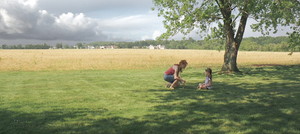
The storm in Curtis’s dream, and one brewing in real life.


Another ill omen, the chlorine spill.



Deward’s wife seen outside his house, and a figure in a similar housecoat in Curtis’s dream, both seen through his windshield.

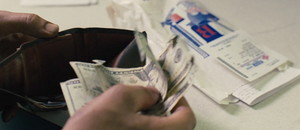

Money worries: Curtis’s prescription co-pay; Sam’s vacation/emergency fund.



Threatened landscapes: a storm captioned “FOR SALE/ Prime Commercial”; Curtis’s world in free-fall.

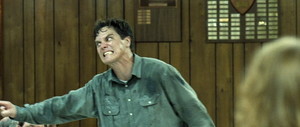
Madman or prophet?


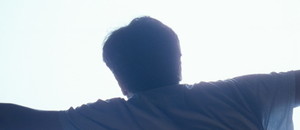
Curtis’s choice between isolation and openness, darkness and light.

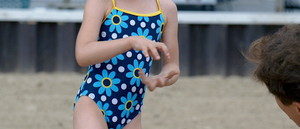
Hannah signs “Storm.”


A man’s home is his castle.
The end of everything
“…Artists are useful to society because they are… super-sensitive. They keel over like canaries in poison coal mines long before more robust types realize that there is any danger whatsoever.” — Kurt Vonnegut, Jr.[1] [open endnotes in new window]
Hollywood has always loved eschatology, especially when it’s photogenic. We’ve seen nuclear missiles incinerate LA, meteors incinerate Paris, and aliens incinerate Washington, New York, and LA; the world spectacularly trashed by glaciers, earthquakes, and megatsunamis; and the entire Earth anticlimactically popped like a soap bubble. Hollywood has rallied its concerted efforts, World War II-style, to keep the public vigilant against the ever-present threat of mass zombiism. This is all just good Thanatotic fun, a culture indolently contemplating its own extinction while eating Twizzlers, like teenagers daydreaming about their own funerals.
But recently a series of independent or foreign films have all addressed the same theme in a more urgent and serious way, either directly or allegorically. These are small, thoughtful movies, not high-concept blockbusters, with indie (or non-) actors instead of action heroes, low production values instead of CGI fireworks, and spare, minimalist scores instead of screaming parodies of Carmina Burana. Take Shelter (Jeff Nichols, 2007) shows us a modern prophet, an ordinary man who’s been vouchsafed a terrible vision of nature in revolt and neighbor turned against neighbor; Meeks’ Cutoff (Kelly Reichardt, 2010) is a parable about Western civilization led astray by its own misguided hubris, doomed unless it changes course; and The Turin Horse (Béla Tarr, 2011) is a frankly apocalyptic fable of God’s covenant reneged on, His Creation revoked, the world corrupted beyond redemption and guttering out in darkness.[2] Taken together, these films seem to be telling us that a terrible storm is coming, that we are at a crossroads, that the end is already here.
Mad in America
Take Shelter opens with a man standing in his driveway, looking up at a dark, coiled bank of stormclouds fluorescing with lightning. It begins to rain. As he looks at the liquid pattering on his fingers, we see it is no ordinary rain; it’s a dirty yellowish-brown, slightly viscous. As he says later, it looks “like motor oil.” The dreamer is Curtis LaForche. He’s having recurring nightmares about a preternatural storm, a storm that not only rains motor oil but turns his neighbors and loved ones into predacious monsters. This storm, like most dream symbols, is multivalent, both terribly specific yet hard to pin down to any one meaning—too ambiguous to be read as an allegory for any particular ecological catastrophe but evoking several at once: acid rain, oil spills, el Niño, Katrina, and all the other destructive weather associated with global warming and climate change. (The weather is indeed getting funny lately; to cite only the current example, at the time of this writing whole swaths of Oklahoma City have been razed by tornadoes.) Its weird oily rain overtly recalls recent real-world environmental disasters, like the Deepwater Horizons spill, but may also allude to peak oil, the theory that warns of the imminent depletion of our petroleum supply, or to the burning of fossil fuels that’s raising the global temperatire. His dreams of catastrophes that threaten his family are echoed by events in the real world of the film; Curtis is absorbed by a local news report about a chlorine spill that killed a man’s wife and daughter. Another dream image, of birds dropping out of the sky by the dozens, flopping spasmodically on the ground, recalls several such freakish incidents in the news (such as when 5000 birds fell out of the sky over Arkansas on New Year’s Eve 2010),[3] but also serves as visual synecdoche for the mass extinction currently underway.
 |
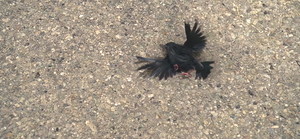 |
| Ill omens. |
But the most terrifying thing about the storm of Curtis’ nightmares is that it somehow turns people against each other. Those touched by its polluted rain become deranged and vicious — pounding at Curtis’s door, clawing at his clothes and face, dragging his daughter out a car window. The figures in his dreams are always glimpsed dimly through fogged and rain-smeared windows, but we can see they’re dressed in the same jeans, T-shirts and nightgowns as his own neighbors, like loved ones turned into ravening zombies in a horror film. In Curtis’ first dream, his dog snarls at him and gnashes his arm; in a later one, his friend and co-worker gores him with a pickaxe; and, in the worst of them, his own wife Sam stands in their kitchen dripping with the telltale rain, staring at him blankly and fixedly, a sharp knife resting near her on the counter. Curtis glances down at the knife, then looks at her and shakes his head, as if pleading, No. This is the most frightening of Curtiss dreams not only because it involves the person closest to him, but because its ambient feeling of incipient violence is left unresolved. The question is left open: will Sam turn on him? The question reverberates in real life, but in reverse: will Curtis turn on her?
These dreams echo Curtis’ mother’s paranoid-schizophrenic delusions—“I thought people were watching me and listening to me,” she whispers to him at her assisted living facility—but they also distortedly prefigure things that happen to him later in the film: his neighbors start talking about him behind his back, his best friend assaults him, his boss fires him, his wife slaps his face. Of course these are self-fulfilling prophecies—Curtis’ friends and wife have been frightened and alienated by his increasingly bizarre behavior. His dreams of his own dog and wife turning against him reflect his fear that he is becoming a dangerous stranger. But people really are being subtly turned against each other by a declining economy, which, like a narrowing ecological niche with a scarcity of resources, inexorably pits its inhabitants against each other. Everyone’s anxieties are about money; Curtis’ friend is angry because he’s been kicked off his work detail, his boss is appalled at the prospect of an uninsured accident, and his wife is furious at what he’s spent on his storm shelter without her knowledge. The onset of Curtis’ mother’s schizophrenia may have been triggered by economic stresses: “Your father was gone a lot and I couldn’t handle things on my own.” Curtis himself is secretly worrying about the price of his medication while his wife is dreaming of a $900-a-week beach rental.
It’s a distinctly working-class world that’s endangered in this film. The settings are middle-class homes with eagle plaques on the aluminum siding, offices in trailers, the generic white corridors and offices of civic buildings, Lion’s Club dining halls with ersatz-wood-paneled walls. We see Curtis operating a drill in a quarry whose sound transitions to the whir of Sam’s sewing machine as she makes a set of curtains for her own home business. Sam haggles over the price of a hand-stitched pillow at a flea market (she initially asks fifteen dollars and settles for eight in change); Curtis forks over forty-seven dollars for medication because the co-pay on his insurance is so high. The film is explicitly set in the post-crash economy: “Banks aren’t loaning money the way they used to,” the loan officer tells Curtis; “You take your eye off the ball one minute in this economy, you’re screwed,” his brother advises; a high-end psychiatrist acknowledges, “I know times are hard.” The phantom lightning storm Curtis sees over an empty lot is captioned by a weathered sign: “FOR SALE: PRIME COMMERCIAL.” The vertiginous sense of a general collapse is evoked by the dream in which Curtis’ living room seems to go into free-fall—the furniture rising into the air, hovering in anticipation of a terrible crash — as if his whole world were in an elevator whose cable has snapped.
But note that, despite an unforgiving economy and indifferent institutions, there’s not a heartless bureaucrat or foreclosing banker to be seen in the film. A harried insurance agent braves the bureaucratic labyrinth of voice mail to get one straight answer that resolves Sam’s problem; the loan officer at the bank urges Curtis not to take out a risky loan against his house; Curtis’s boss is a decent enough guy who seems sick at having to fire him. These are all overworked, underpaid people trying to do the best they can in an inefficient and dilapidated system. When the counselor Curtis has come to trust disappears and is replaced by a new one who tries to start over from square one, it isn’t anyone’s fault; it’s just how things are. As in Curtis’ dream, it’s the system, the storm, that’s forcing these people to fight one another. (In a deleted scene, when Curtis’ counselor asks him why people are attacking him in his dreams, he shrugs: “it’s in the air.”)
The one stable element in Curtis’ world is family. This is a portrait of a happy marriage. His best friend tells him, “You got a good life, Curtis. I think that’s the best compliment you can give a man--take a look at his life, say: ‘That’s good. That guy’s doin’ something right.’” Curtis signs “I—love—you” to his deaf daughter, Hannah, before he heads to work; he teases his wife out of being angry at him when he turns up late and smelly from work to Hannah’s ASL class. As the couple stands in their daughter’s bedroom doorway at night, we see a sampler on the wall of three bunnies huddled with a gray cloud hovering over them, raindrops falling, and a heart inscribed in the air above them, their love a frail umbrella against the storm.
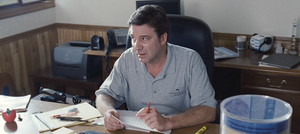 |
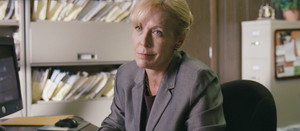 |
 |
 |
| Sympathetic functionaries in really depressing interiors. | |
 |
 |
| See the bunnies? | A book on the shelf has the title, “Mad in America.” In the context of the film, it suggests a political rather than a psychological reading. |
Curtis is afraid he may be going crazy but fears, even more, that he isn’t; we see him methodically reading up on the diagnostic criteria for schizophrenia, quizzing his mother about the symptoms of her own onset, and seeking professional help, but also, simultaneously, preparing for the apocalyptic storm foretold in his visions by expanding and fortifying his storm shelter, buying canned goods and gas masks. It’s a painful portrait of a man methodically pursuing cross-purposes. His last name, LaForche, means “the fork,” alluding to both his bifurcated behavior and the decision he faces.
Curtis begins having waking dreams. He hears claps of thunder out of an empty sky. He sees flocks of birds describing undulant arabesques in the air, as if the universe is trying to tell him something in sign. The question he asks, standing on the roadside watching an eerily beautiful lightning display crackling blue and purple over an open field, might be that of any clear-eyed man in a world blind with denial: “Is anyone seein’ this?” Neither he nor we know until the film’s end, if then, whether these are symptoms of incipient schizophrenia or supernatural visions. This ambiguity calls on the audience to decide whether we’re going to interpret the film as psychological portrait or political metaphor--as a naturalistic story about a man losing his mind or a parable about a modern seer with a vision of our world in peril. When Curtis loses it at a Lions’ Club dinner, thundering at his neighbors like a wild-eyed Old Testament prophet, “THERE IS A STORM COMING LIKE NOTHING YOU HAVE EVER SEEN AND NOT A ONE OF YOU IS PREPARED FOR IT!” our reaction is a litmus test: do we cringe in embarrassment or exult at hearing the truth spoken? Is Curtis a schizophrenic in need of medication or a prophet without honor in his hometown? (It’s not unlike the tension in the The Shining (Stanley Kubrick, 1980) between the realistic likelihood that Jack Torrance is losing his mind and the supernatural possibility that the ghosts are real.)
The film’s crucial moment comes when Curtis has to make his own choice between the personal and the social: to keep himself and his family barricaded in the dark or open the shelter’s door and risk letting in the outside world.
This tension is intensified to the breaking point by the film’s ending, when the storm finally appears. On first viewing this seems like a deliberately ambiguous coda, one that can be taken as literal reality or yet another nightmare. But we never wake up from this one. And Curtis’ wife and daughter don’t act like the people in his dreams, ravening or affectless; they are themselves. It’s also the first time in the film that we see the storm from a point of view other than Curtis’. His daughter Hannah sees it first—she makes the swirling sign for “storm” that she learned early in the film—and then his wife sees it, too--we see it reflected in the sliding glass doors behind her as she emerges from the beach house, and over her shoulder as she looks out at the vast roiling storm front, its multiple waterspouts reaching like tentacles toward an iron-gray ocean. This isn’t an ambiguous ending; the film’s title turns out to be an imperative. Sam nods wordlessly at Curtis; he nods back. It is an inversion of the awful charged moment from his dream when she stared at him with implacable menace and he shook his head beseechingly. The family will not turn on itself; if they are to die they will do it together.
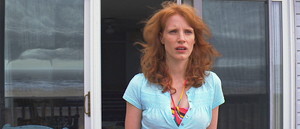 |
 |
| Samantha sees Curtis’s reality at last — reflected in glass ... | ... and over-the-shoulder. |
 |
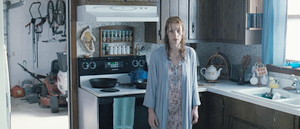 |
Curtis shakes his head no at Sam in his dream... |
... pleading with her not to turn against him... |
 |
 |
…and Sam nods yes to Curtis ... |
... affirming her faith and loyalty to him in real life. |
When we first saw Curtis and Hannah on the beach he was digging a moat around a sand castle, another fragile barricade like the fantasy of security he was buying with his storm shelter. There’s a last shot, as Curtis picks up his daughter and runs, of their abandoned castle crumbling on the beach. What we’re going to have to leave behind in order to survive was never going to last anyway.
To
top![]() Print
version
Print
version![]() JC 55
JC 55 ![]() Jump
Cut home
Jump
Cut home

This work is licensed under a Creative Commons Attribution-NonCommercial-NoDerivs 2.5 License.